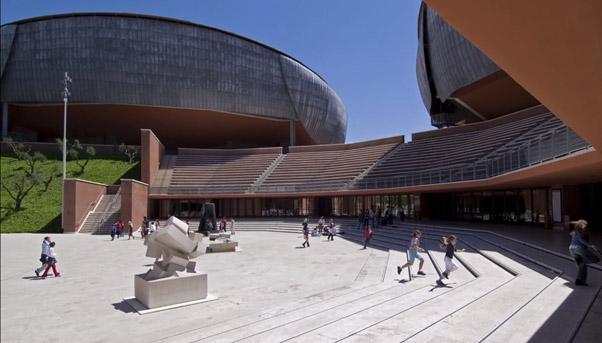
Salini Impregilo might not do residential buildings, but it does – at times – build something like “homes”. And these homes are usually places that institutions – rather than families – can call their own.
Take the Auditorium Parco della Musica in Rome, built by Salini Impregilo from 2000.
It is the heart of the performing arts of Rome as well as home to Italy’s national music academy, the Accademia Nazionale di Santa Cecilia.
Before the Auditorium opened in 2002, the academy, one of the oldest classical music institutions in the world, had had no fixed address for more than half a century.
Forced by Benito Mussolini to abandon the Augusteo music hall for excavation works in 1936, it had moved from one venue to another until local authorities finally commissioned Salini Impregilo to build a place deserving of an institution of its stature with the help of star architect Renzo Piano. It could be said that it was worth the wait.
Located in a northern neighbourhood next to the Olympic Village, the Auditorium Parco della Musica is the most visited multifunctional cultural centre in the world after the Lincoln Centre of New York, drawing more than one million visitors every year. It is a complex of buildings nestled amid the trees of a park of about 55,000 square metres. There are three concert halls, an amphitheatre, rehearsal studios, museums and other spaces dedicated to the arts. The concert halls have curved metal roofs that make them resemble large beetles. The largest sits 2,700, the second 1,200 and the third 700. Some 21,700 square metres of their interiors are fitted with cherry wood from North America – a material unprecedented in Italy at the time of construction – to obtain some of the best acoustics in the country. The amphitheater, situated at the centre of the complex, has space for 3,000 spectators for open-air performances. In addition to the cherry wood, Salini Impregilo used three main materials to finish the complex: curtain bricks (1.8 million units) to cover the foyers and the exterior; travertine (26,000 square metres) for the floors of the hall lobbies; and lead (18,000 square metres) for the roofs of the halls. There’s also a car park for 200 vehicles. As Piano explains on the Auditorium’s website, it met the desire of local authorities to bring new life to the city.
“Cultural locations…have the natural ability of enriching the urban texture…and give back that extraordinary quality that (they have) always had in history,” he says. “(It) is not simply an Auditorium, but a complete City of Music.”
The auditorium’s success comes from the plurality of its offering. It invites people to come enjoy a concert, browse in its bookstore or view an exhibit at the gallery. In music, it hosts everything from classical to jazz to rock to experimental. And two other institutions dedicated to the promotion of music, film and theatre have joined the academy in making the auditorium their home: the Fondazione Musica per Roma and the Fondazione Cinema per Roma, which hosts the international Rome Film Fest every October.
The complex is not what Piano had originally planned, however. As often happens at a construction site in Rome, workers uncovered a series of ruins during preliminary excavations in 1995, forcing him to alter the lay-out of the Auditorium to accommodate them. He had to have two of the concert halls – the Santa Cecilia and the Sinopoli – built on either side of the foundations of an ancient farmhouse and villa. The relics unearthed from inside the remains of the walls of these two buildings are on display at one of the museums on the grounds.
This role as an arts venue for everyone was evident from the beginning. The performances held to celebrate its 2002 inauguration ranged from South Korean Myung-Whun Chung conducting the academy’s orchestra to Patty Smith leading her New York band of rockers. But classic music holds a special place at the Auditorium, with the biggest of the three concert halls – the Santa Cecilia – its exclusive preserve. In a sign that repeat performances are also possible in the world of infrastructure, Salini Impregilo and Piano have come back together to build another cultural centre in a European capital: Athens. Funded by the Stavros Niarchos Foundation, the centre will be home to the national opera and the national library. Work began in 2012.

